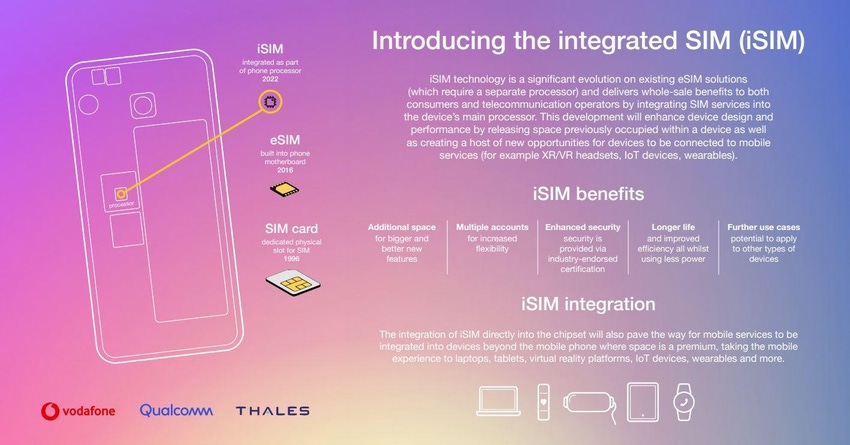Integrated SIMs (iSIMs) took another step closer to commercialisation this week, and they promise to bring with them significant benefits for consumer tech and cellular IoT.
January 19, 2022

Integrated SIMs (iSIMs) took another step closer to commercialisation this week, and they promise to bring with them significant benefits for consumer tech and cellular IoT.
On Tuesday, Vodafone, Qualcomm and Thales successfully carried out a proof-of-concept (PoC) demonstration with a Samsung Galaxy Z Flip3 equipped with an iSIM, a milestone which they claim paves the way for the fully-fledged rollout of the technology.
A quick explainer for anyone wondering what an iSIM is and how it differs from an eSIM. An eSIM is a dedicated piece of hardware attached to a device’s circuit board, whereas an iSIM is hosted entirely on a device’s processor. In the case of this week’s demonstration, the processor in question was a Qualcomm Snapdragon 888, equipped with Thales’ iSIM software. The demo took place at a Samsung R&D lab, where the smartphone was connected to Vodafone’s network using the operator’s remote management platform.
Freeing up the space previously used for a physical SIM means smartphones can get even sleeker than they are already. It also improves performance because it removes a minor bottleneck from the system since the processor isn’t having to communicate with a separate component. There is the added benefit of removing the cost of buying and installing that separate component too. In addition, it is more or less impossible to physically tamper with an iSIM compared to a traditional SIM card or even an eSIM, since there isn’t really anything to tamper with. Of course, just like eSIMs, iSIMs can also be provisioned instantly and over-the-air by any operator provided with an activation key.
The promise of an even thinner, competitively-priced phone that works slightly better should be more than enough excitement for one day. However, die-hard thrill-seekers will be pleased to hear that iSIM also offers considerable benefits to the IoT market. The major upside is that it paves the way for smaller, cheaper devices with even better battery life. It could extend the appeal of cellular IoT connectivity to applications where module size, weight and cost are limiting factors, like keeping track of individual, high-value items of mail, for example.
“Our aim is to create a world where every device connects seamlessly and simply to each other, and the customer has complete control. The iSIM, combined with our remote management platform, is a major step in this direction, allowing devices to be connected without a physical SIM or dedicated chip, making connectivity to many objects – the promise of the connected IoT world – a reality,” said Alex Froment-Curtil, chief commercial officer at Vodafone, in a statement.
“iSIM solutions offer great opportunities to MNOs, free-up valuable space in devices for OEMs, and provide flexibility for device users to benefit from the full potential of 5G networks and experiences across a wide range of device categories,” added Enrico Salvatori, SVP and president, EMEA, at Qualcomm Europe.
When chip designer ARM introduced the iSIM in 2018, it said the technology would help fulfil its vision of a trillion connected devices by 2035. It was a bold prediction back then, and it still is today. Forecasts vary, but IoT Analytics reckons there will be 41.2 billion connected devices by the end of 2025, with IoT accounting for 30.9 billion of them.
Meanwhile, research firm Transforma Insights is even more conservative. It predicts that by 2030 there will be 28 billion IoT connections alone; it doesn’t offer a forecast on non-IoT connections, but you can be confident that it will be fewer than 28 billion. Regardless of which prediction ends up being the most accurate, there would have to be some fairly exponential growth for connections to come close to reaching 1 trillion. What does matter to the mobile operators though, is what proportion of those connections are cellular. With technology like iSIM, that proportion promises to be higher.
About the Author(s)
You May Also Like








.png?width=300&auto=webp&quality=80&disable=upscale)


_1.jpg?width=300&auto=webp&quality=80&disable=upscale)


.png?width=800&auto=webp&quality=80&disable=upscale)